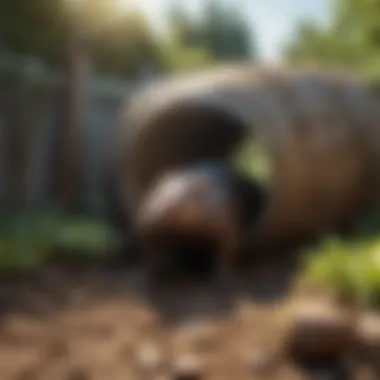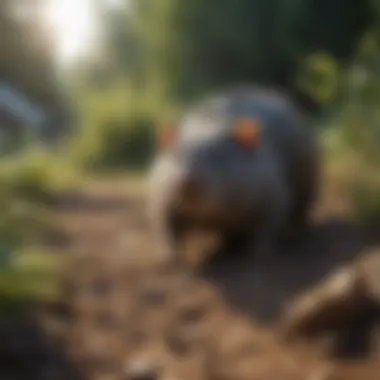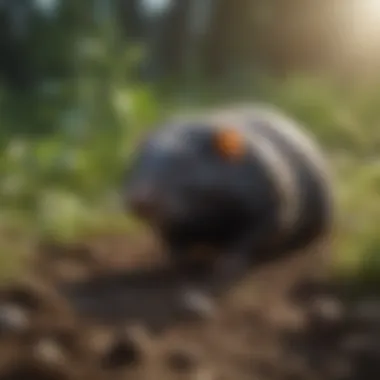Effective Treatments for Moles in Your Yard


Intro
Moles are small mammals that can cause significant damage to lawns and gardens. They dig extensive tunnels underground, which can disrupt the layout of your yard, uproot plants, and create unsightly mounds. Understanding how to manage these pests effectively is crucial for maintaining a healthy outdoor space. This article delves into the different aspects of mole management, focusing on identification, prevention, and treatment strategies.
Pest Identification
To effectively tackle a mole problem, one must first accurately identify the pest. Moles typically measure about 6 to 8 inches in length, and they possess a cylindrical body, velvety fur, and short limbs equipped with powerful claws for digging.
Detailed Descriptions of Common Pests
The most common type of mole found in North America is the Eastern mole, which is recognizable by its pointed snout and small eyes. These creatures are subterranean and rarely seen above ground. Unlike some other pests, moles primarily feed on insects, particularly grubs and worms, which can be beneficial for soil health.
Signs and Symptoms of Infestations
Signs of a mole infestation include:
- Mounds of soil: These are often created as moles dig their tunnels, pushing earth to the surface.
- Tunnels: Surface tunnels can appear as raised ridges in the soil, indicating active foraging behavior.
- Damaged lawn: Uneven patches of grass can indicate mole activity, as roots are disturbed or uprooted.
Being aware of these signs can help homeowners act quickly to manage moles effectively.
Prevention Strategies
Implementing effective prevention strategies can help keep moles at bay and ensure the integrity of your yard.
Home Maintenance Tips for Pest Prevention
- Regular Lawn Care: Maintain a healthy lawn through regular mowing and aeration. This can deter the food sources that attract moles.
- Remove Debris: Clear away mulch, leaves, and other organic matter that can harbor insects, making your yard less appealing to moles.
Natural Deterrents and Barriers
In addition to regular lawn care, the following natural deterrents may prove useful:
- Castor oil: This substance can be mixed with water and applied to the lawn. Its scent is unpleasant to moles.
- Vibrating devices: Solar-powered devices that create ground vibrations can deter moles from establishing themselves in your yard.
Treatment Options
When moles invade your yard, there are various treatment options available, ranging from chemical methods to humane traps.
Overview of Chemical vs. Natural Treatments
Chemical treatments can include rodenticides, which aim to eliminate moles quickly. However, these methods may pose risks to pets and wildlife. Natural treatments, on the other hand, are often safer alternatives that focus on deterrence or humane removal.
Step-by-Step Guides for DIY Treatments
To implement a natural treatment, consider the following steps:
- Identify active tunnels: Observe the mounds and tunnels to find the most active paths.
- Set traps: Use a humane trap, placing it within the active tunnel without disturbing the surrounding area too much. Follow the manufacturer's instructions carefully.
- Monitor the traps: Check them multiple times a day and relocate moles as needed, ensuring that they are placed in a suitable environment far away from residential areas.
Each step contributes to effective mole management without compromising the health of your yard.
Understanding Moles
Understanding moles is vital for homeowners looking to maintain their yards effectively. Knowledge of the biology and behavior of these small mammals can significantly influence the approach to manage them. Moles can create extensive underground burrows that not only disturb the soil but also threaten the integrity of lawns and gardens. Therefore, understanding how moles operate aids in identifying appropriate and effective management strategies.
Biology of Moles
Moles belong to the family Talpidae and are primarily adapted for a subterranean lifestyle. Their cylindrical bodies, velvety fur, and short limbs make them excellent diggers. Moles have specialized forelimbs that are broad and strong, enabling them to tunnel through the earth with great efficiency. They possess a high metabolic rate, which requires them to consume large amounts of food, primarily earthworms and grubs.
Moles generally weigh between 5 to 12 ounces and have a lifespan of around three years in the wild. Their eyes are small and not very effective for vision. Instead, moles rely heavily on their incredibly sensitive whiskers and keen sense of smell to navigate their dark environments.
Behavioral Patterns
Moles are solitary creatures, except during breeding seasons. They are primarily active during the spring and fall. Moles dig intricate tunnel systems, which can spread over 100 feet in a single night. These tunnels serve as foraging paths and nesting sites. Moles tend to create surface ridges in yards as they push the soil up when burrowing just beneath the surface.
In terms of territory, one mole can occupy an area ranging from 400 to 2,000 square feet. Moles are territorial and will defend their burrows from other moles. Understanding these behaviors can assist homeowners in identifying and monitoring mole activity within their properties.
Signs of Infestation
Detecting moles in your yard involves observing several key indicators:
- Surface Mounds: The most obvious sign of a mole presence is the small volcano-shaped mounds of soil that they create as they dig. These mounds indicate active burrowing.
- Ridges and Tunnels: Visible ridges in the grass often indicate underground tunnels. If you press down on the grass and it feels spongy, this can further confirm mole activity.
- Damaged Plants: Occasionally, the roots of garden plants can be disturbed, which may lead to wilting or dying plants. This can happen when moles dig around the root systems in search of food.
Identifying these signs can help in assessing the extent of a mole infestation and deciding on the most effective treatment options.
Assessing the Impact of Moles
Understanding the impact of moles is critical for homeowners facing potential infestations. This section addresses the consequences these creatures can have on yards and gardens. Knowing the effects allows informed decisions during control efforts, ultimately preserving the integrity of outdoor spaces.
Potential Damage to Lawns
Moles primarily dig tunnels in search of food, which consists mainly of grubs and earthworms. Though they can improve soil aeration, their tunneling can have adverse effects on lawns. The surface disruptions they cause lead to uneven ground, making it difficult to enjoy a smooth lawn.
- Bare Spots: Over time, repeated digging can create holes, leading to patches of grass that die.
- Soil Compaction: The presence of moles can disturb the soil structure. When the lawn becomes uneven, it can also lead to water pooling in low areas, causing further risk to grass health.
- Aesthetic Issues: An unsightly yard can decrease property value and lessen outdoor enjoyment. This visual impact is often a concern for homeowners.


Effects on Garden Plants
Moles can also affect the health of garden plants. Their burrowing activities can disrupt root systems of various plants. For instance, sensitive plant roots may be exposed or damaged due to underground activity, resulting in stunted growth or even death of the plants.
- Root Damage: When moles tunnel, they may intersect with roots. This can lead to a decrease in nutrient and water absorption.
- Soil Disturbance: The soil disturbance can make it challenging for some plants to establish and grow properly.
- Competing Species: Moles can inadvertently create conditions that favor other pests, such as slugs, which can harm vulnerable plants.
Interactions with Other Pests
Moles are unique in their role within the ecosystem of yards. Their presence can have interactions with other pest populations. Understanding these dynamics is crucial for effective management.
- Beneficial Insects: Moles are often seen as a benefit to gardens due to their predation on pest larvae but can affect the populations of beneficial insects too.
- Predator and Prey Dynamics: A home to moles can attract predators like owls and hawks. Increased activity from these larger pests could ultimately represent challenges for other small animals in the yard.
- Status as Pest Controllers: While moles can help with pest control, homeowners must consider both sides of the equation. Their activity can control some pests while encouraging others that may damage gardens or lawns.
Preventive Measures
Addressing the issue of moles in your yard starts with prevention. Moles can cause significant disruption to your lawn and gardens. Taking proactive steps can help minimize their presence and protect your outdoor spaces. In this section, we delve into various strategies to prevent moles from invading your yard. Each method has its benefits and considerations.
Maintaining Healthy Soil
Healthy soil is crucial for discouraging moles. The presence of insects, grubs, and earthworms can attract moles who search for food. To maintain healthy soil, consider the following:
- Regular Soil Testing: Test for pH and nutrient levels to ensure optimum soil conditions. Adjust accordingly with amendments.
- Aeration: Aerate the soil to improve drainage and promote root health. This action can reduce the likelihood of attracting moles.
- Organic Matter: Incorporate organic matter into the soil. Well-balanced soil supports strong plant growth and keeps pest populations in check.
Taking care of your soil not only nurtures plants but can also make your yard less appealing to moles looking for rich feeding grounds.
Landscaping Adjustments
Your landscaping choices can significantly influence the attraction of moles. Modifying how you arrange and maintain your garden can deter them from settling in.
- Select Wisely: Choose plants that are less conducive to attracting moles, such as those that do not support a large population of grubs.
- Avoid Excess Moisture: Moles prefer areas with damp soil, as it hosts more food sources. Ensure proper drainage in your yard to diminish their chances of establishing a home.
- Mulching: While mulch is beneficial for many plants, it can attract insects. Opt for less enticing materials or use mulch sparingly.
Making conscious landscaping adjustments builds a less inviting habitat for moles while enhancing the overall health of your yard.
Using Natural Repellents
Natural repellents can be an effective way to deter moles without resorting to chemicals. They create an environment that is less welcoming.
- Castor Oil: This substance is known to repel moles. Mixing it with water and applying it to your yard can create a less attractive area for moles.
- Essential Oils: Oils like peppermint and eucalyptus are often effective. They can mask food smells, dissuading moles from coming near.
- Plant-Based Solutions: Certain plants, like marigolds, can serve as natural repellents. Their strong scent can deter moles while beautifying your yard.
Using these natural methods can create a strong defense against moles and support an eco-friendlier yard management approach.
Preventive measures are often more effective than reactive solutions. Addressing moles before they make a home in your yard is key to protecting its integrity.
In summary, implementing preventive measures requires understanding your yard's ecology, making thoughtful choices in soil management, landscaping, and using natural repellents. By doing so, you can create a less favorable environment for moles that promotes a healthier and more vibrant lawn.
Identification Techniques
Understanding how to identify moles in your yard is an essential step in managing their presence effectively. Without proper identification, it becomes challenging to differentiate moles from other burrowing animals. This section will provide insights into various tools and methods that aid in recognizing moles and assessing the situation before proceeding with treatment.
Visual Identification
Moles have distinct physical traits that can help homeowners identify them quickly. They are small mammals with cylindrical bodies, velvety fur, and a characteristic pointed snout. Adult moles are typically about 6 to 8 inches long, often featuring large, spade-like front paws adapted for digging. These paws are an essential feature as they assist in creating underground tunnels.
Another visible sign is their unique way of moving through the soil. Usually, moles create raised ridges in the grass, marking their tunnels and feeding grounds. These ridges lead to small mounds of loose soil, which may appear on the surface. If your yard exhibits these signs, there's a strong chance you have moles.
Monitoring Techniques
Monitoring is critical in recognizing the ongoing activity of moles in your yard. Setting up simple observation points can help track their movements and assess the level of infestation. Look for daily or weekly signs of activity around the mounds. Checking for fresh soil or new tunnel appearances can provide valuable insights into their burrowing patterns.
You can also use motion-activated cameras to capture images of any burrowing animals. This method is particularly effective if you're unsure whether you are dealing with moles or other rodents, such as voles.
Differentiating Moles from Other Animals
Moles are often confused with other ground-dwelling animals, such as voles and gophers. Understanding the differences is vital.
- Moles typically create long, raised tunnels on the surface and have distinctive fur and body shape. They primarily consume insects and earthworms.
- Voles, in contrast, have a stocky build and round bodies. They create shallow burrows and primarily eat grass and plants.
- Gophers do mound-making and create a more straightforward hole without visible tunneling.
Familiarizing yourself with these differences will give you a clearer picture of your yard's pest issues and help in choosing the right treatment strategies moving forward.
Treatment Options
Effective treatment options are essential in managing moles in your yard. These methods can prevent further damage, protect your landscaping, and maintain the health of your garden. By understanding the various treatment options available, homeowners can make informed decisions that suit their circumstances. Moreover, these options help to balance the need for pest control with the aim to protect local wildlife and ecosystems.
Humane Trapping
Humane trapping is one of the most sought-after treatment options for dealing with moles. This method focuses on capturing moles without harming them, making it a preferable choice for many environmentally conscious homeowners.
Types of Traps
There are various types of traps designed specifically for moles. Common types include scissor traps and harpoon traps. Each type has its own operation mechanism, leading to distinctive ways of capturing moles. Scissor traps are designed to snap shut when moles pass through, efficiently capturing them. Harpoon traps penetrate the mole when activated, assuring a swift and humane result.
The key characteristic of these traps is their effectiveness in capturing moles without causing any physical injury to them. This is a benefit for those who prefer not to harm the animals or want to relocate them. However, a disadvantage is that these traps require proper knowledge for effective use. Improper setting can lead to traps being ineffective.
Setting Up Traps Effectively
Setting traps correctly is crucial for success. Selecting an active mole tunnel is an important step. It increases the likelihood of capturing moles. The key characteristic is the need for patience and observation. Homeowners must regularly monitor their yards to determine the most frequently traveled paths of these animals.


Furthermore, placing traps in a concealed manner can enhance their effectiveness. However, this requires careful consideration of the mole's behavior. A wrong setup might result in traps being missed, causing frustration to those trying to eliminate the problem.
Caring for Captured Moles
Caring for captured moles involves ensuring their welfare and safety post-capture. Avoiding prolonged confinement in traps is important. A key characteristic of caring for captured moles is relocating them responsibly to a suitable environment, away from residential areas. This choice appeals to environmentally responsible individuals who want to reduce local wildlife disruption.
However, the unique feature of this act is the responsibility it carries. Relocating local wildlife may not always be allowed due to local regulations. Moreover, in some cases, returning moles to their natural habitat quickly is crucial to their survival. Failure to do so can lead to unnecessary stress or injury to the animal.
Chemical Solutions
Chemical solutions are another approach but require careful consideration due to potential environmental impacts. These treatments often involve pesticides and might influence surrounding ecosystems. Understanding this balance is important for informed decision-making.
Types of Pesticides
When selecting pesticides, homeowners often encounter a variety of options. There are common formulations that specifically target moles, such as bait and granules. The key characteristic of these products is their efficacy in repelling or eliminating moles, but they can have consequences for non-target species.
This choice might provide immediate relief from mole activity but can pose risks to pets and beneficial insects. Therefore, the use of these products often requires a delicate balance between short-term solutions and long-term environmental health.
Application Techniques
Application techniques significantly influence the effectiveness of chemical treatments. Proper timing and application method ensure that the chemicals reach the targeted moles effectively. The key characteristic here is the ability to read and understand the instructions closely.
Homeowners should apply pesticides during peak mole activity times for better results. However, improper application may not only lead to ineffective pest control, but it may also harm beneficial organisms in their yards.
Environmental Concerns
Environmental concerns are paramount when considering chemical solutions. Responsible use of pesticides demands awareness of surrounding wildlife and flora. The key characteristic of this consideration is sustainability.
Those who opt for chemicals should deeply evaluate the possible repercussions of their choices. This includes understanding potential impacts on local ecosystems, as well as adhering to regulations on chemical use. Ignoring these aspects might lead to unintended harm in your yard and beyond.
Natural Remedies
Natural remedies are growing in popularity among homeowners seeking eco-friendly pest control options. These solutions can provide a gentler approach with less harm to local wildlife.
Essential Oils
Essential oils serve as a repellent for many pests, including moles. Oils such as peppermint or castor oil are often utilized due to their strong scents, which tend to deter moles. The key characteristic of essential oils is their natural origin, providing a non-toxic alternative for yard management.
However, the effectiveness of these oils can vary depending on local conditions. They might require frequent reapplication, presenting a disadvantage for some homeowners who prefer long-lasting solutions.
Plant-Based Solutions
Plant-based solutions involve utilizing specific plants known for their repellent properties. For instance, planting marigolds can offer a natural deterrent for moles while beautifying your yard. The key characteristic here is the dual benefit of enhancing garden aesthetics while assisting in pest management.
However, they may take time to establish effectiveness as barriers. This approach relies on natural processes and often requires ongoing commitment to see results in pest control.
Effectiveness of Natural Repellents
The effectiveness of natural repellents often varies greatly among different species of moles and their environments. Homeowners may need to experiment with various solutions to find what works best for their specific yard. The key feature of this process is its trial-and-error nature.
Post-Treatment Care
Post-treatment care is crucial after dealing with moles in your yard. Addressing the aftermath effectively can help to restore your landscape and minimize potential future infestations. This phase introduces a systematic approach to rejuvenating your outdoor space, ensuring soil health and visual appeal. When you successfully remove moles, you also need to consider how to promote a thriving environment for lawn and garden restoration.
Restoring the Yard
Re-seeding Bare Patches
Re-seeding bare patches in your yard is an important step for restoration after treating for moles. When moles tunnel through soil, they can disrupt grass roots and create unsightly holes. Thus, re-seeding becomes vital not just for aesthetics but for the overall health of your lawn. By sowing grass seeds in disturbed areas, you promote recovery and growth of grass.
The immediate advantage of re-seeding lies in its simplicity. It is easy to implement and does not require special tools. However, one must ensure proper timing and suitable seed selection for optimal results. A disadvantage could be the potential for the new grass to be less established against future pest invasions. Nevertheless, a healthy lawn can often deter further infestations.
Improving Soil Health
Improving soil health is another key component of post-treatment care. Healthy soil influences plant growth and resilience against pests, including moles. You can achieve better soil health by conducting tests to assess nutrient levels and making necessary amendments. Adding organic matter or worm castings can enhance soil fertility and improve its structure.
The key characteristic of healthy soil is its ability to retain moisture and nutrients. Investing time in soil improvement can yield significant long-term benefits. Conversely, neglecting soil health can lead to recurring pest issues and weak plants. Therefore, maintaining a balanced ecosystem in your yard fosters not just grass but also a thriving garden overall.
Maintenance Practices
Establishing maintenance practices plays a vital role in post-treatment care. Regular upkeep reduces the likelihood of future mole infestations. Make a habit of maintaining lawn height, watering adequately, and controlling potential food sources for moles, such as grubs.
The unique feature of effective maintenance practices is their preventive nature. They help keep the yard attractive while ensuring that conditions do not favor moles. These practices promote overall yard health but can become time-consuming. By adhering to a consistent schedule, you can secure a beautiful landscape that minimizes pest issues.
Monitoring for Recurrence
Monitoring for recurrence is essential in ensuring that your efforts are effective and lasting. Regular check-ups can help identify if moles return, allowing for timely intervention.
Regular Inspections
Conducting regular inspections helps you to recognize early signs of mole activity. This technique focuses on checking for new tunnels or disturbances in the soil. By staying vigilant, you can address potential problems before they spiral out of control.
The benefit of consistent inspections lies in their proactive nature. You get informed about your yard's condition without relying solely on visual indicators. However, the downside could be the need for frequent dedication to yard surveillance, especially during active seasons.
Signs of New Activity


Understanding the signs of new activity is critical for a successful follow-up. Noticing fresh mole mounds or new tunnel systems can indicate a return of these pests. Rapid identification enables prompt action, preventing a full-blown recurrence.
Highlighting the characteristic of immediate feedback, you can adjust strategies based on these signs. While observing changes can be helpful, it may also be challenging to discern between old and new signs. Thorough knowledge of mole behavior enhances this assessment process.
Adjusting Prevention Strategies
If you notice signs of new activity, adjusting your prevention strategies is key to maintaining a mole-free yard. You may need to reevaluate and fortify existing methods. For instance, changing your landscaping or using different repellents can provide new deterrents.
The flexibility of adjusting strategies allows you to adapt to changing mole behavior and environmental conditions. A drawback can be the trial-and-error nature of finding the most effective solution. To ensure continuous improvement of your yard management practices, keep detailed records on what strategies work best in your particular environment.
When to Consult Professionals
The issue of moles in your yard can become quite significant. Understanding when to engage professional pest control services is essential for effective management. If you notice signs of a severe infestation, timely intervention can prevent further damage to your landscape. Consulting with professionals offers access to expert knowledge and experience that may not be available to the average homeowner. It is particularly critical during specific phases of infestation when the actions taken can either remedy the situation or exacerbate it further.
In assessing whether to call in the experts, several factors should be considered. For instance, if your attempts at control have failed repeatedly, it might indicate that the problem requires specialized methods that professionals are more equipped to handle. They bring advanced tools and a deeper understanding of mole behavior which can lead to a more permanent solution than over-the-counter methods. If the mole damage extends into the foundation or infrastructure of your home, professional intervention is often necessary.
Assessing Severity of Infestation
The first step in deciding to consult professionals is to assess the severity of the mole invasion in your yard. Examine the extent of the damage caused, including the size of the tunnels and mounds. Knowing whether the mole population is small or substantial informs how urgent the need for professional help might be.
A minor issue may be manageable with home remedies, but a heavy infestation might overwhelm your efforts. Factors like how rapidly the mole damage is occurring, the size of your yard, and the presence of natural predators should also influence your decision. If these elements suggest a growing problem, seeking professional assistance becomes more pertinent.
Choosing a Pest Control Service
Selecting the right pest control service is pivotal for effectively managing mole issues. Doing thorough research can help you find a service that not only addresses your mole problem but does so ethically and sustainably.
Evaluating Credentials
When evaluating credentials of pest control companies, check for proper licensing and certifications. A licensed service demonstrates compliance with local regulations. This not only ensures that the methods used are safe but reflects a basic level of professionalism. Many of these services will have trained technicians who understand the legal implications of mole control.
Look for companies that have positive reviews and a solid track record within your community. A strong network within the local area often indicates reliability. However, while some companies may promote themselves heavily, it is their history of effective service that should carry the most weight in your decision.
Understanding Services Offered
Understanding the range of services offered by a pest control company is essential. Not all services handle moles in the same way. Some may focus primarily on chemical treatments, while others may specialize in humane trapping or integrated pest management. Assessing these offerings can help align your expectations with the methods that will be used.
Look for services that prioritize humane treatment options. A company that offers eco-friendly solutions may also fit your values better, especially if you have pets or children. It's important, then, to ask questions about their specific approaches to mole removal to ensure that they match your preferences and needs.
Cost Considerations
Cost considerations are also a key factor when choosing pest control services. Prices can vary widely based on the service provider’s experience, location, and the extent of the infestation.
It might be tempting to choose the cheapest service available. However, skimping on quality can lead to unsatisfactory results and potentially increased costs in the long run if the issue is not resolved properly. A higher initial investment might be necessary for a more effective, long-term solution.
Be clear about what the quoted price entails so you avoid unexpected extras. Comparing estimates from several companies can also give you an idea of fair pricing and help you make a more informed decision.
Ultimately, selecting a qualified service can mean the difference between a successful resolution of a mole problem and ongoing frustration.
In summary, understanding when to involve professionals goes beyond mere identification of moles in your yard. It encompasses a thorough evaluation of infestation severity, careful consideration of service providers, and an awareness of costs involved.
Regulatory Considerations
Understanding regulatory considerations is crucial when dealing with moles in your yard. Each region has specific laws related to wildlife and pest control. Compliance with these regulations protects not only the local ecosystem but also homeowners from legal repercussions. Ignoring these laws can lead to hefty fines and contribute to the decline of wildlife populations. Thus, familiarizing oneself with local wildlife regulations ensures responsible management of moles while promoting a balanced environment.
Local Wildlife Regulations
Every state or municipality may have different regulations regarding the treatment of moles. These regulations often govern what methods can be used for population control, including restrictions on certain chemicals or traps. Some regions may even classify moles as protected species, thus requiring special permits for control measures that could harm them. To navigate these complexities:
- Research Local Laws: Look into wildlife regulations in your area. Websites of local government or wildlife agencies usually publish this information.
- Check with Experts: Consulting with pest control professionals familiar with local laws can help avoid unintentional violations.
- Stay Informed on Changes: Wildlife regulations can evolve, so it is advisable to stay updated on any changes in the law.
Best Practices for Ethical Treatment
Ethics plays an essential role in pest management. Using humane and environmentally conscious approaches not only adheres to regulations but reinforces responsible homeowner practices. Here are some recommended best practices:
- Use Humane Trapping Methods: Traps designed to capture moles without harm are widely available. Place these traps in active tunnels for effective results.
- Avoid Poisonous Chemicals: Pesticides can have serious consequences on non-target species and the ecosystem. Opt for natural solutions whenever possible.
- Educate Others: Share knowledge about ethical treatment of moles with neighbors and community members. Awareness can lead to more responsible behaviors in managing wildlife.
"Understanding and respecting wildlife regulations not only protects your community but also preserves the integrity of local ecosystems."
In summary, being aware of regulatory considerations and implementing ethical treatment methods fosters a sustainable approach to managing moles in your yard. Homeowners must prioritize these aspects to balance personal preferences with ecological responsibility.
Closure
In this article, we explored the various strategies for treating moles in yards, emphasizing that a comprehensive approach is essential for effective management. Understanding the biology and behavior of moles provides critical insights that help homeowners make informed decisions. The significance of recognizing signs of infestation cannot be overstated; early detection can lead to more effective interventions.
Key elements discussed include:
- Identification techniques that aid in confirming the presence of moles.
- Preventive measures to maintain yard health and discourage moles from becoming a problem.
- A range of treatment options, from humane trapping to natural remedies and chemical solutions.
- Importance of post-treatment care for restoring yard integrity.
- Regulatory considerations ensuring humane and legal management of wildlife.
Understanding these facets allows homeowners to maintain a healthy, mole-free yard while considering the ethical implications of pest management. Each aspect contributes to a holistic view of yard care that emphasizes both effectiveness and conscientiousness.
Summary of Key Points
The discussion highlighted several essential points:
- Knowing when moles are active is key for effective monitoring.
- Soil health can either attract or repel moles; proper maintenance is crucial.
- Natural remedies, while beneficial, often require complementary methods for best results.
- Professional help can be invaluable when infestations reach a critical level, providing expertise that may go beyond home remedies.
- Regulations vary; homeowners must research local policies to ensure compliance.
Final Thoughts on Yard Management
Managing moles in your yard is more than just removing pests. It calls for a balance between keeping your lawn healthy and addressing the presence of moles humanely. Incorporating practices such as regular yard monitoring and soil maintenance not only helps manage mole populations but also enhances the overall aesthetics and health of your outdoor space.
By staying informed and adaptable, homeowners can protect their properties effectively while respecting local wildlife. For those looking to dive deeper, platforms like Reddit provide community insights, and exploration of pages on Wikipedia can offer valuable supplemental information. Keeping abreast of advancements in pest management strategies is vital for successful yard care.

